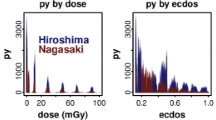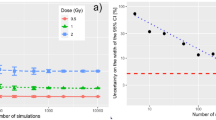Abstract
Epidemiological studies of cancer rates associated with external and internal exposure to ionizing radiation have been subject to extensive reviews by various scientific bodies. It has long been assumed that radiation-induced cancer risks at low doses or low-dose rates are lower (per unit dose) than those at higher doses and dose rates. Based on a mixture of experimental and epidemiologic evidence the International Commission on Radiological Protection recommended the use of a dose and dose-rate effectiveness factor for purposes of radiological protection to reduce solid cancer risks obtained from moderate-to-high acute dose studies (e.g. those derived from the Japanese atomic bomb survivors) when applied to low dose or low-dose rate exposures. In the last few years there have been a number of attempts at assessing the effect of extrapolation of dose rate via direct comparison of observed risks in low-dose rate occupational studies and appropriately age/sex-adjusted analyses of the Japanese atomic bomb survivors. The usual approach is to consider the ratio of the excess relative risks in the two studies, a measure of the inverse of the dose rate effectiveness factor. This can be estimated using standard meta-analysis with inverse weighting of ratios of relative risks using variances derived via the delta method. In this paper certain potential statistical problems in the ratio of estimated excess relative risks for low-dose rate studies to the excess relative risk in the Japanese atomic bomb survivors are discussed, specifically the absence of a well-defined mean and the theoretically unbounded variance of this ratio. A slightly different method of meta-analysis for estimating uncertainties of these ratios is proposed, motivated by Fieller’s theorem, which leads to slightly different central estimates and confidence intervals for the dose rate effectiveness factor. However, given the uncertainties in the data, the differences in mean values and uncertainties from the dose rate effectiveness factor estimated using delta-method-based meta-analysis are not substantial, generally less than 70%.
Similar content being viewed by others
Availability of data and material
The paper has no data, so this is judged not applicable.
Code availability
The paper has no code, so this is judged not applicable.
References
Carroll RJ, Ruppert D, Stefanski LA, Crainiceanu CM (2006) Measurement error in nonlinear models. A modern perspective. Boca Raton, FL, Chapman and Hall/CRC: 1–488
Chakravarti IM (1971) Confidence set for the ratio of means of two normal distributions when the ratio of variances is unknown. Biometrische Zeitschr 13(2):89–94
Committee to Assess Health Risks from Exposure to Low Levels of Ionizing Radiation, National Research Council (2006) Health Risks from Exposure to Low Levels of Ionizing Radiation: BEIR VII Phase 2. DC, National Academy Press, Washington DC, USA pp 1–406
DerSimonian R, Laird N (1986) Meta-analysis in clinical trials. Control Clin Trials 7(3):177–188
Fieller EC (1940) The biological standardization of insulin. Suppl J Roy Statist Soc 7(1):1–64
Fieller EC (1954) Some problems in interval estimation. J Royal Statist Soc Series B 16(2):175–185
Haley BM, Paunesku T, Grdina DJ, Woloschak GE (2015) The increase in animal mortality risk following exposure to sparsely ionizing radiation is not linear quadratic with dose. PLoS ONE 10(12):e0140989
Hamra GB, MacLehose R, Richardson D, Bertke S, Daniels RD (2014) Modelling complex mixtures in epidemiologic analysis: Additive versus relative measures for differential effectiveness. Occup Environ Med 71(2):141–146
Hoel DG (2018) Nuclear epidemiologic studies and the estimation of DREF. Int J Radiat Biol 94(4):307–314
International Commission on Radiological Protection (ICRP) (2007) The 2007 Recommendations of the International Commission on Radiological Protection. ICRP publication 103. Ann ICRP 37(2–4):1–332
Jacob P, Rühm W, Walsh L, Blettner M, Hammer G, Zeeb H (2009) Is cancer risk of radiation workers larger than expected? Occup Environ Med 66(12):789–796
Kocher DC, Apostoaei AI, Hoffman FO, Trabalka JR (2018) Probability distribution of dose and dose-rate effectiveness factor for use in estimating risks of solid cancers from exposure to low-LET radiation. Health Phys 114(6):602–622
Kocher DC, Apostoaei AI, Hoffman FO (2019) Response to Wakeford et al. Health Phys 116(1):100–101
Little MP, Pawel D, Misumi M, Hamada N, Cullings HM, Wakeford R, Ozasa K (2020) Lifetime mortality risk from cancer and circulatory disease predicted from the Japanese atomic bomb survivor Life Span Study data taking account of dose measurement error. Radiat Res 194(3):259–276
Preston DL, Pierce DA, Shimizu Y, Cullings HM, Fujita S, Funamoto S, Kodama K (2004) Effect of recent changes in atomic bomb survivor dosimetry on cancer mortality risk estimates. Radiat Res 162(4):377–389
Preston DL, Ron E, Tokuoka S, Funamoto S, Nishi N, Soda M, Mabuchi K, Kodama K (2007) Solid cancer incidence in atomic bomb survivors: 1958–1998. Radiat Res 168(1):1–64
Rühm W, Woloschak GE, Shore RE, Azizova TV, Grosche B, Niwa O, Akiba S, Ono T, Suzuki K, Iwasaki T, Ban N, Kai M, Clement CH, Bouffler S, Toma H, Hamada N (2015) Dose and dose-rate effects of ionizing radiation: a discussion in the light of radiological protection. Radiat Environ Biophys 54(4):379–401
Shore R, Walsh L, Azizova T, Rühm W (2017) Risk of solid cancer in low dose-rate radiation epidemiological studies and the dose-rate effectiveness factor. Int J Radiat Biol 93(10):1064–1078
Stram DO, Preston DL, Sokolnikov M, Napier B, Kopecky KJ, Boice J, Beck H, Till J, Bouville A (2015) Shared dosimetry error in epidemiological dose-response analyses. PLoS ONE 10(3):e0119418
Thomas D, Stram D, Dwyer J (1993) Exposure measurement error: influence on exposure-disease relationships and methods of correction. Annu Rev Public Health 14:69–93
Tran V, Little MP (2017) Dose and dose rate extrapolation factors for malignant and non-malignant health endpoints after exposure to gamma and neutron radiation. Radiat Environ Biophys 56(4):299–328
United Nations Scientific Committee on the Effects of Atomic Radiation (UNSCEAR) (2008) UNSCEAR 2006 Report. E.08.IX.6. Annex A. Epidemiological Studies of Radiation and Cancer. New York, United Nations, pp 13–322
Viechtbauer W (2005) Bias and efficiency of meta-analytic variance estimators in the random-effects model. J Educ Behavioral Stat 30(3):261–293
Wakeford R, Azizova T, Dörr W, Garnier-Laplace J, Hauptmann M, Ozasa K, Rajaraman P, Sakai K, Salomaa S, Sokolnikov M, Stram D, Sun Q, Wojcik A, Woloschak G, Bouffler S, Grosche B, Kai M, Little MP, Shore RE, Walsh L, Rühm W (2019) The dose and dose-rate effectiveness factor (DDREF). Health Phys 116(1):96–99
Zander A, Paunesku T, Woloschak GE (2020) Analyses of cancer incidence and other morbidities in gamma irradiated B6CF1 mice. PLoS ONE 15(8):e0231510
Zhang Z, Preston DL, Sokolnikov M, Napier BA, Degteva M, Moroz B, Vostrotin V, Shiskina E, Birchall A, Stram DO (2017) Correction of confidence intervals in excess relative risk models using Monte Carlo dosimetry systems with shared errors. PLoS ONE 12(4):e0174641
Acknowledgements
The authors are grateful for detailed and helpful comments of Professor David Richardson and the three referees.
Funding
The Intramural Research Program of the National Institutes of Health, the National Cancer Institute, Division of Cancer Epidemiology and Genetics supported the work of MPL, who was also supported by the International Commission on Radiological Protection Task Group 91, of which he is a member.
Author information
Authors and Affiliations
Contributions
All authors contributed equally. MPL provided the original draft of paper.
Corresponding author
Ethics declarations
Conflicts of interest
The authors have no conflicts of interests.
Ethics approval
The research does not involve human or animal subjects, so ethical approval is judged not applicable.
Consent to participate
The research does not involve human or animal subjects, so consent to participate is judged not applicable.
Consent for publication
All authors gave consent for publication.
Additional information
Publisher's Note
Springer Nature remains neutral with regard to jurisdictional claims in published maps and institutional affiliations.
Supplementary Information
Below is the link to the electronic supplementary material.
Rights and permissions
About this article
Cite this article
Little, M.P., Pawel, D.J., Abalo, K. et al. Methodological improvements to meta-analysis of low dose rate studies and derivation of dose and dose-rate effectiveness factors. Radiat Environ Biophys 60, 485–491 (2021). https://doi.org/10.1007/s00411-021-00921-x
Received:
Accepted:
Published:
Issue Date:
DOI: https://doi.org/10.1007/s00411-021-00921-x




